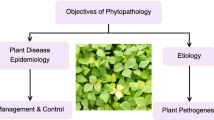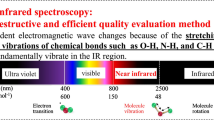Abstract
Hyperspectral imaging is useful for detecting internal defects of pickling cucumbers. The technique, however, is not yet suitable for high-speed online implementation due to the challenges in analyzing large-scale hyperspectral images. This research aimed to select the optimal wavebands from the hyperspectral image data, so that they can be deployed in either a hyperspectral or multispectral imaging-based inspection system for the automatic detection of internal defects of pickling cucumbers. Hyperspectral reflectance (400–700 nm) and transmittance (700–1,000 nm) images were acquired, using an in-house developed hyperspectral imaging system running at two conveyor speeds of 85 and 165 mm/s, for 300 “Journey” pickling cucumbers before and after internal damage was induced by mechanical load. Minimum redundancy–maximum relevance (MRMR) was used for optimal wavebands selection, and the loadings of principal component analysis (PCA) were also applied for qualitatively identifying the important wavebands that are related to the specific features. Discriminant analysis with Mahalanobis distance classifier was performed for the two-class (i.e., normal and defective) and three-class (i.e., normal, slightly defective, and severely defective) classifications using the mean spectra and textural features (energy and variance) from the regions of interest in the spectral images at selected waveband ratios. The classification results based on MRMR wavebands selection were generally better than those from PCA-based classifications. The two-band ratio of 887/837 nm from MRMR gave the best overall classification results, with the accuracy of 95.1 and 94.2 % at the conveyor speeds of 85 and 165 mm/s, respectively, for the two-class classification. The highest classification accuracies for the three-class classification based on the optimal two-band ratio of 887/837 nm were 82.8 and 81.3 % at the conveyor speeds of 85 and 165 mm/s, respectively. The mean spectra-based classification achieved better results than the textural feature-based classification, except in the three-class classification for the higher conveyor speed. The overall classification accuracies for all selected waveband ratios at the low conveyor speed were slightly higher than those at the higher conveyor speed, since the low speed resulted in more scan lines, thus higher spatial resolution hyperspectral images. The identified two-band ratio of 887/837 nm in transmittance mode could be applied for fast real-time internal defect detection of pickling cucumbers.







Similar content being viewed by others
References
Ariana, D. P., & Lu, R. (2008a). Quality evaluation of pickling cucumbers using hyperspectral reflectance and transmittance imaging: Part I. Development of a prototype. Sensing and Instrumentation for Food Quality and Safety, 2(3), 144–151.
Ariana, D. P., & Lu, R. (2008b). Detection of internal defect in pickling cucumbers using hyperspectral transmittance imaging. Transactions of the ASABE, 51(2), 705–713.
Ariana, D. P., & Lu, R. (2010a). Evaluation of internal defect and surface color of whole pickles using hyperspectral imaging. Journal of Food Engineering, 96(4), 583–590.
Ariana, D. P., & Lu, R. (2010b). Hyperspectral waveband selection for internal defect detection of pickling cucumbers and whole pickles. Computers and Electronics in Agriculture, 74(1), 137–144.
Blasco, J., Aleixos, N., & Molto, E. (2003). Machine vision system for automatic quality grading of fruit. Biosystems Engineering, 85(4), 415–423.
Camps, C., & Christen, D. (2009). Non-destructive assessment of apricot fruit quality by portable visible-near infrared spectroscopy. Lwt-Food Science and Technology, 42(6), 1125–1131.
Cen, H., & Lu, R. (2009). Quantification of the optical properties of two-layer turbid materials using a hyperspectral imaging-based spatially-resolved technique. Applied Optics, 48(29), 5612–5623.
Cernadas, E., Carrion, P., Rodriguez, P.G., Muriel, E., & Antequera, T. (2005). Analyzing magnetic resonance images of Iberian pork loin to predict its sensorial characteristics. Computer Vision and Image Understanding, 98(2), 344–360.
Chao, K. L., Yang, C. C., & Kim, M. S. (2011). Line-scan spectral imaging system for online poultry carcass inspection. Journal of Food Process Engineering, 34(1), 125–143.
Chen, G. Y., & Qian, S. E. (2009). Denoising and dimensionality reduction of hyperspectral imagery using wavelet packets, neighbour shrinking and principal component analysis. International Journal of Remote Sensing, 30(18), 4889–4895.
Cheng, X., Chen, Y. R., Tao, Y., Wang, C. Y., Kim, M. S., & Lefcourt, A. M. (2004). A novel integrated PCA and FLD method on hyperspectral image feature extraction for cucumber chilling damage inspection. Transactions of the ASABE, 47(4), 1313–1320.
Clark, C. J., McGlone, V. A., & Jordan, R. B. (2003). Detection of Brownheart in ‘Braeburn’ apple by transmission NIR spectroscopy. Postharvest Biology and Technology, 28(1), 87–96.
Costa, C., Antonucci, F., Pallottino, F., Aguzzi, J., Sun, D. W., & Menesatti, P. (2011). Shape analysis of agricultural products: a review of recent research advances and potential application to computer vision. Food and Bioprocess Technology, 4(5), 673–692.
Firtha, F. (2007). Development of data reduction function for hyperspectral imaging. Progress in Agricultural Engineering Sciences, 3(1), 67–88.
Gómez-Sanchis, J., Blasco, J., Soria-Olivas, E., Lorente, D., Escandell-Montero, P., Martínez-Martínez, J. M., et al. (2013). Hyperspectral LCTF-based system for classification of decay in mandarins caused by Penicillium digitatum and Penicillium italicum using the most relevant bands and non-linear classifiers. Postharvest Biology and Technology, 82, 76–86.
Gowen, A. A., Taghizadeh, M., & O’Donnell, C. P. (2009). Identification of mushrooms subjected to freeze damage using hyperspectral imaging. Journal of Food Engineering, 93(1), 7–12.
Han, D. H., Tu, R. L., Lu, C., Liu, X. X., & Wen, Z. H. (2006). Nondestructive detection of brown core in the Chinese pear ‘Yali’ by transmission visible-NIR spectroscopy. Food Control, 17(8), 604–608.
Iwasaki, A., & Todoroki, A. (2004). Delamination identification of CFRP structure by discriminant analysis using Mahalanobis distance. Key Engineering Materials, 270–273, 1859–1865.
Kawamura, K., Watanabe, N., Sakanoue, S., Lee, H. J., Inoue, Y., & Odagawa, S. (2010). Testing genetic algorithm as a tool to select relevant wavebands from field hyperspectral data for estimating pasture mass and quality in a mixed sown pasture using partial least squares regression. Grassland Science, 56(4), 205–216.
Lawrence, K. C., Windham, W. R., Park, B., & Buhr, R. J. (2003). A hyperspectral imaging system for identification of faecal and ingesta contamination on poultry carcasses. Journal of Near Infrared Spectroscopy, 11(4), 269–281.
Leiva-Valenzuela, G. A., Lu, R., & Aguilera, J. M. (2013). Prediction of firmness and soluble solids content of blueberries using hyperspectral reflectance imaging. Journal of Food Engineering, 115(1), 91–98.
Lorente, D., Aleixos, N., Gómez-Sanchis, J., Cubero, S., & Blasco, J. (2013). Selection of optimal wavelength features for decay detection in citrus fruit using the ROC curve and neural networks. Journal of Food Engineering, 6(2), 530–541.
Lu, R. (2003). Detection of bruises on apples using near-infrared hyperspectral imaging. Transactions of the ASAE, 46(2), 523–530.
Lu, R., & Ariana, D. P. (2013). Detection of fruit fly infestation in pickling cucumbers using a hyperspectral reflectance/transmission imaging system. Postharvest Biology and Technology, 81(1), 44–50.
Lu, R. & Chen, Y. R. (1998). Hyperspectral imaging system for safety inspection of food and agricultural products. In: Proceedings of SPIE, 3544, 1 November, Boston, MA, USA.
Lu, R., Guyer, D. E., & Beaudry, R. M. (2000). Determination of firmness and sugar content of apples using near-infrared diffuse reflectance. Journal of Texture Studies, 31(6), 615–630.
Martinez, L., Thornsbury, S., & Nagai, T. (2006). National and international factors in pickle markets. East Lansing: Department of Agricultural Economics, Michigan State University.
Miller, A. R., Kelley, T. J., & White, B. D. (1995). Nondestructive evaluation of pickling cucumbers using visible-infrared light transmission. Journal of the American Society for Horticultural Science, 120(6), 1063–1068.
Park, B., Lawrence, K. C., Windham, W. R., & Smith, D. P. (2006). Performance of hyperspectral imaging system for poultry surface fecal contaminant detection. Journal of Food Engineering, 75(3), 340–348.
Peng, Y., & Lu, R. (2008). Analysis of spatially resolved hyperspectral scattering images for assessing apple fruit firmness and soluble solids content. Postharvest Biology and Technology, 8(1), 52–62.
Peng, H., Long, F., & Ding, C. (2005). Feature selection based on mutual information: criteria of max-dependency, max-relevance, and min-redundancy. IEEE Transactions on Pattern Analysis and Machine Intelligence, 27(8), 1226–1238.
Qin, J., Burks, T. F., Kim, M. S., Chao, K., & Ritenour, M. A. (2008). Citrus canker detection using hyperspectral reflectance imaging and PCA-based image classification method. Sensing and Instrumentation for Food Quality and Safety, 2(3), 168–177.
Qin, J., Burks, T. F., Ritenour, M. A., & Bonn, W. G. (2009). Detection of citrus canker using hyperspectral reflectance imaging with spectral information divergence. Journal of Food Engineering, 93(2), 183–191.
Qin, J., Burks, T. F., Zhao, X., Niphadkar, N., & Ritenour, M. A. (2011). Multispectral detection of citrus canker using hyperspectral band selection. Transactions of the ASABE, 54(6), 2331–2341.
Serpico, S. B., & Bruzzone, L. (2001). A new search algorithm for feature selection in hyperspectral remote sensing images. IEEE Transactions on Geoscience and Remote Sensing, 39(7), 1360–1367.
Singh, N., & Delwiche, M. J. (1994). Machine vision methods for defect sorting stonefruit. Transactions of the ASABE, 37(6), 1989–1997.
Teerachaichayut, S., Kil, K. Y., Terdwongworakul, A., Thanapase, W., & Nakanishi, Y. (2007). Non-destructive prediction of translucent flesh disorder in intact mangosteen by short wavelength near infrared spectroscopy. Postharvest Biology and Technology, 43(2), 202–206.
Torbick, N., & Becker, B. (2009). Evaluating principal components analysis for identifying optimal bands using wetland hyperspectral measurements from the Great Lakes, USA. Remote Sensing, 1(3), 408–417.
Varma, M., & Zisserman, A. (2004). A statistical approach to texture classification from single images. Netherlands: Kluwer Academic Publishers.
Wang, J. H., Sun, X. D., Pan, L., Sun, Q., & Han, D. H. (2008). Discrimination of brownheart and watercore of apples based on energy spectrum of visible/near infrared transmittance. Spectroscopy and Spectral Analysis, 28(9), 2098–2102.
Westland, S., & Ripamonti, C. (2004). Computational colour science using MATLAB. Chichester: Wiley.
Author information
Authors and Affiliations
Corresponding author
Rights and permissions
About this article
Cite this article
Cen, H., Lu, R., Ariana, D.P. et al. Hyperspectral Imaging-Based Classification and Wavebands Selection for Internal Defect Detection of Pickling Cucumbers. Food Bioprocess Technol 7, 1689–1700 (2014). https://doi.org/10.1007/s11947-013-1177-6
Received:
Accepted:
Published:
Issue Date:
DOI: https://doi.org/10.1007/s11947-013-1177-6




